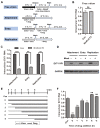Scorpion Venom Antimicrobial Peptide Derivative BmKn2-T5 Inhibits Enterovirus 71 in the Early Stages of the Viral Life Cycle In Vitro
- PMID: 38785952
- PMCID: PMC11117539
- DOI: 10.3390/biom14050545
Scorpion Venom Antimicrobial Peptide Derivative BmKn2-T5 Inhibits Enterovirus 71 in the Early Stages of the Viral Life Cycle In Vitro
Abstract
Enterovirus 71 (EV71), a typical representative of unenveloped RNA viruses, is the main pathogenic factor responsible for hand, foot, and mouth disease (HFMD) in infants. This disease seriously threatens the health and lives of humans worldwide, especially in the Asia-Pacific region. Numerous animal antimicrobial peptides have been found with protective functions against viruses, bacteria, fungi, parasites, and other pathogens, but there are few studies on the use of scorpion-derived antimicrobial peptides against unenveloped viruses. Here, we investigated the antiviral activities of scorpion venom antimicrobial peptide BmKn2 and five derivatives, finding that BmKn2 and its derivative BmKn2-T5 exhibit a significant inhibitory effect on EV71. Although both peptides exhibit characteristics typical of amphiphilic α-helices in terms of their secondary structure, BmKn2-T5 displayed lower cellular cytotoxicity than BmKn2. BmKn2-T5 was further found to inhibit EV71 in a dose-dependent manner in vitro. Moreover, time-of-drug-addition experiments showed that BmKn2-T5 mainly restricts EV71, but not its virion or replication, at the early stages of the viral cycle. Interestingly, BmKn2-T5 was also found to suppress the replication of the enveloped viruses DENV, ZIKV, and HSV-1 in the early stages of the viral cycle, which suggests they may share a common early infection step with EV71. Together, the results of our study identified that the scorpion-derived antimicrobial peptide BmKn2-T5 showed valuable antiviral properties against EV71 in vitro, but also against other enveloped viruses, making it a potential new candidate therapeutic molecule.
Keywords: BmKn2-T5; EV71; antimicrobial peptides; antiviral activity; scorpion venom peptides.
Conflict of interest statement
The authors declare no conflicts of interest.
Figures





References
MeSH terms
Substances
Grants and funding
- 2023YFC2307800/National Key Research and Development Program of China
- 2023AB08097/Key Program of Science and Technology Department of Guangxi
- RAZ24010001/Project of Southern Marine Science and Engineering Guangdong Laboratory
- 32161160303/National Science Fund of China
- JCYJ20230807090212024/Shenzhen Science and Technology Program of China
LinkOut - more resources
Full Text Sources

